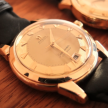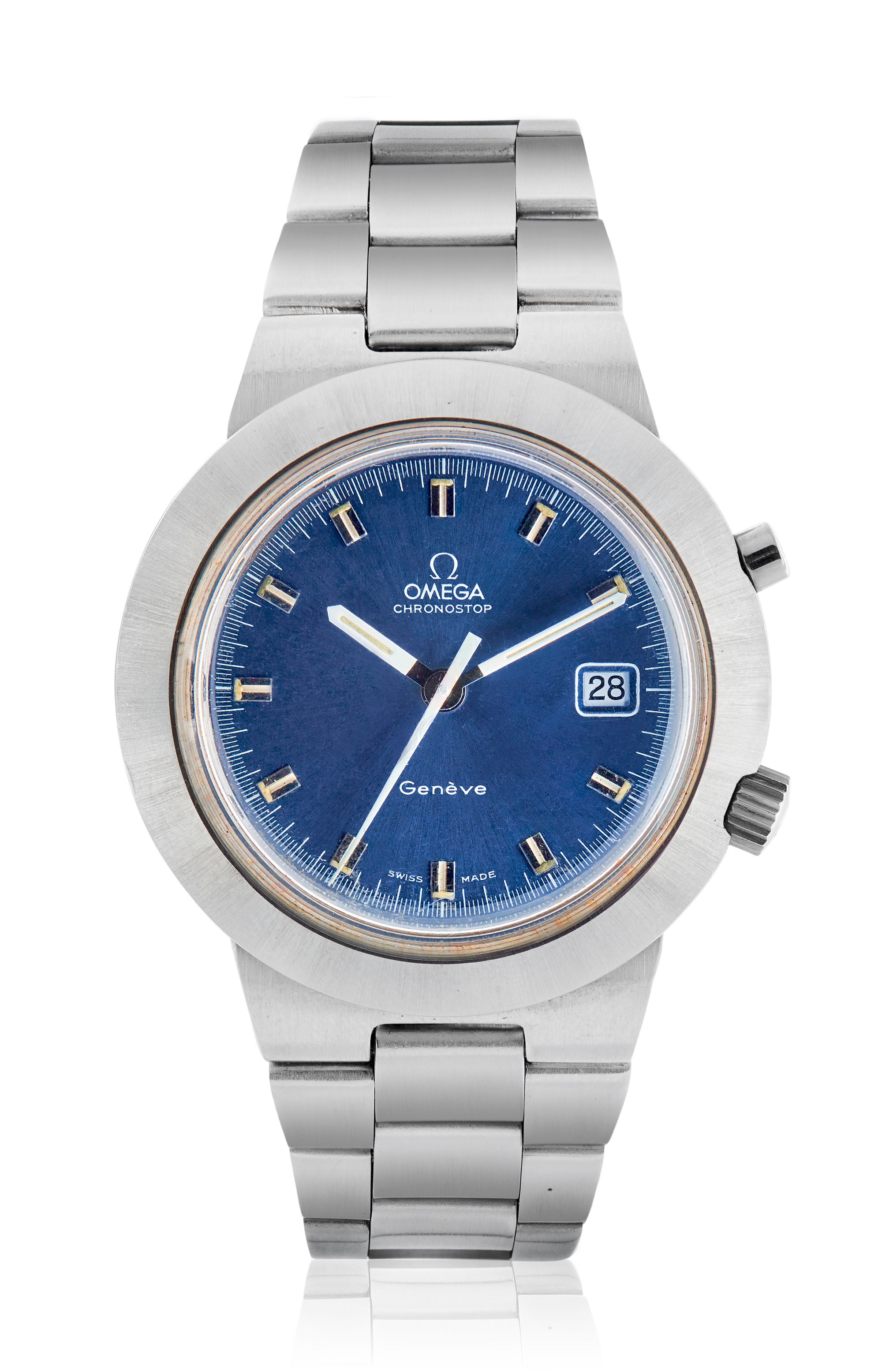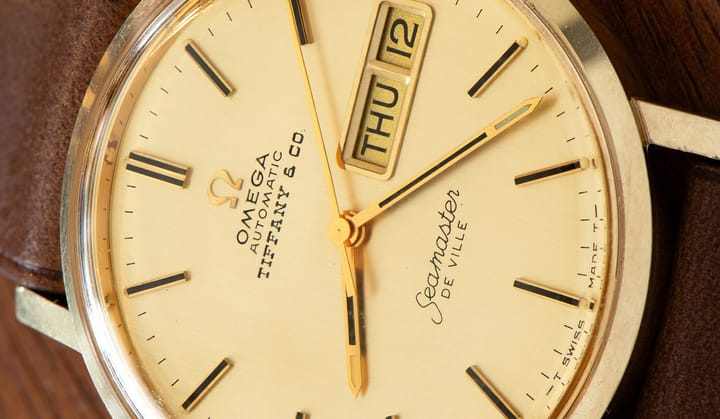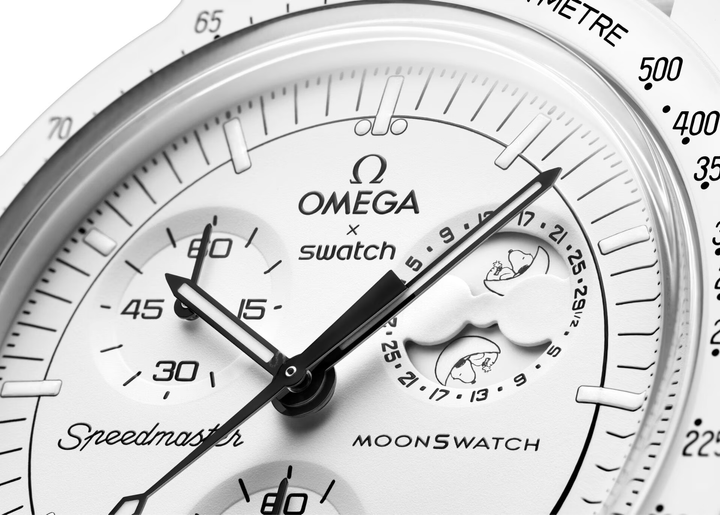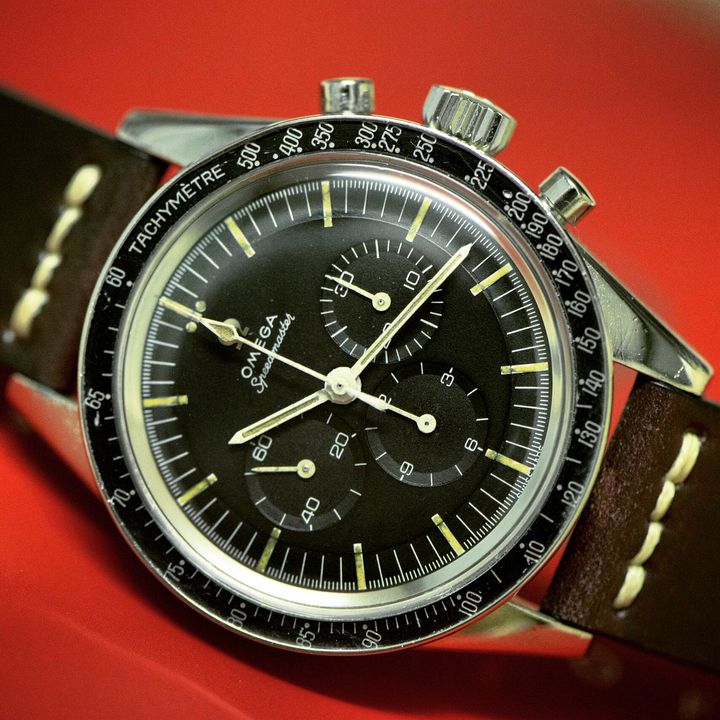Our journey into the Chronostop model lines ventures into Italy with the Chronostop Pentatlon, also known as the Chronostop Fontana, and the little known Lemania & De Ville variants of this case design.
A Continuation of the Series
This is part 2 in a 4 part series about the Omega Chronostop line. For the first part, about the original Geneve Chronostop and Japanese variants, click the link below:
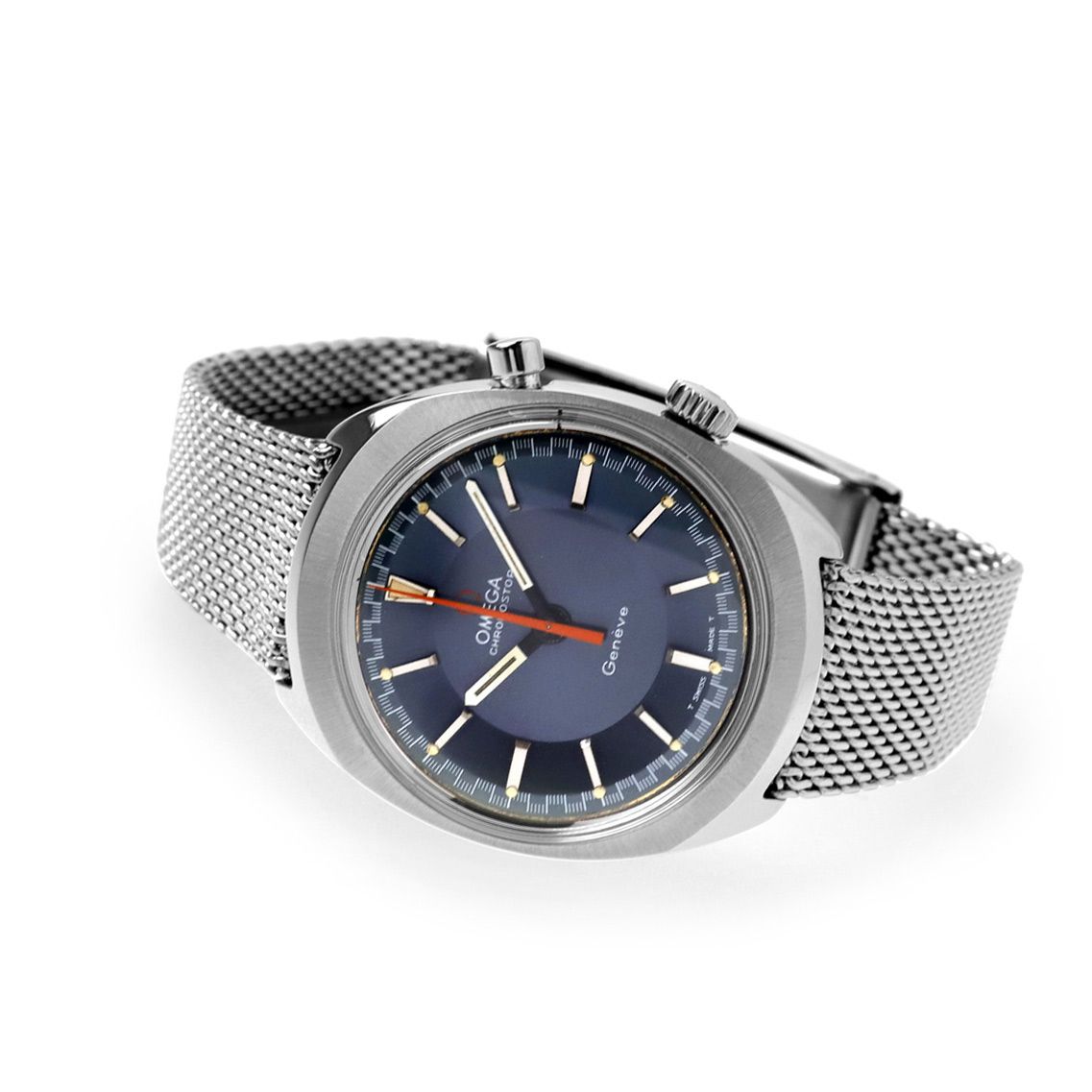
The Italian Geneve Chronostop
The Italian market Geneve Chronostop models are a major departure from the original design. They combine simple, minimalist, almost teutonic dial designs with an integrated bracelet, and a case borrowed from the Geneve Dynamic. While the Geneve Dynamic is a watch that really isn't all that loved by collectors, these Chronostop models take that case and do something quite different and special with it. It may not sound like the most compelling recipe, yet this watch is far greater than the sum of its parts and comes together to produce a watch that is both sporty and remarkably elegant.
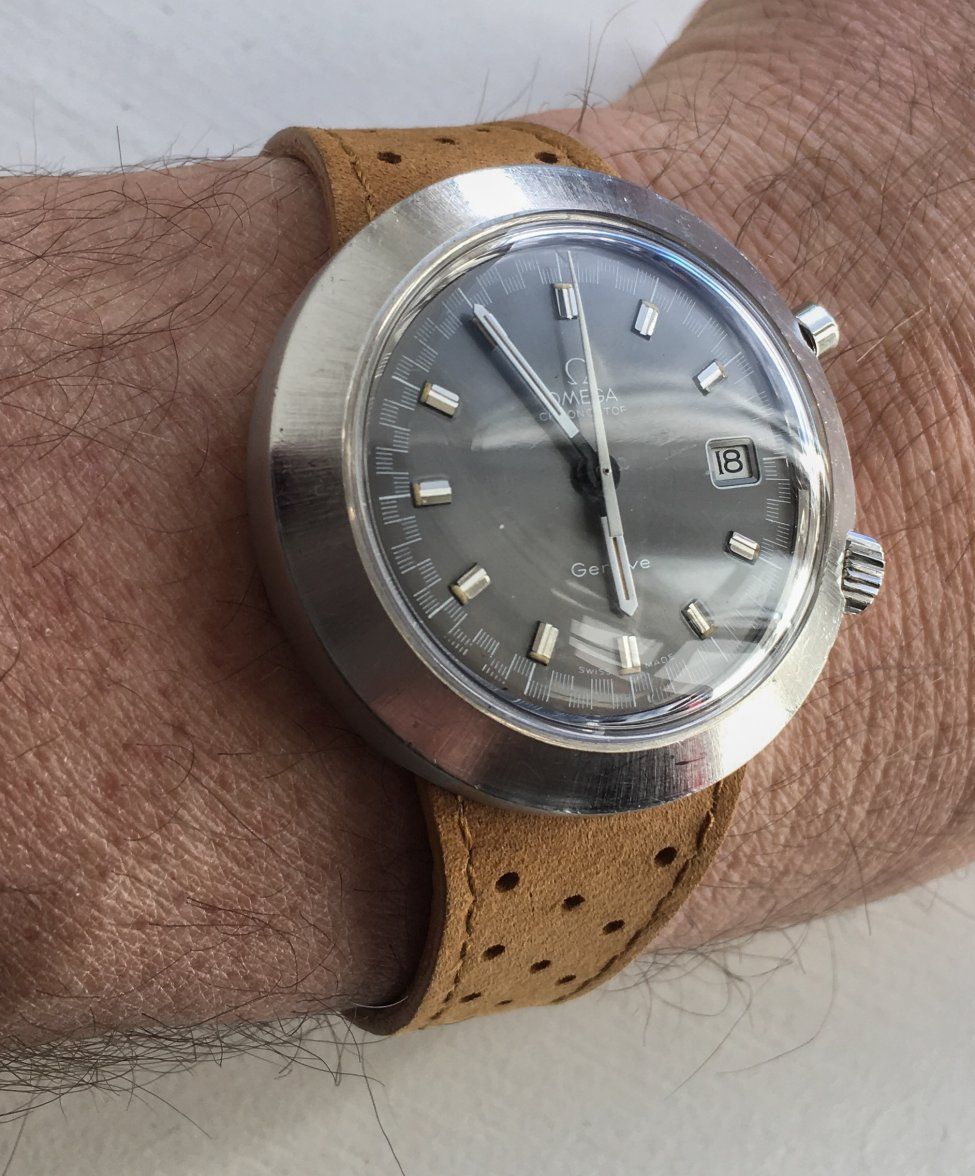
The substantial size and meaty bezel give this watch a genuine presence on the wrist, something that can be found slightly lacking in the original Chronostop. It feels like a modern sports watch on the wrist as the design is not dated or pigeonholed in a specific decade. Italian watch collectors are known to be passionate about chronographs and for having exceptional taste, and these watches definitely live up to that.
While the watch is simple, the number of different names and descriptions these watches are given is incredibly confusing. The reference is the same for all of them and easy to remember, 146.012. Sometimes they are called the "Italian Geneve Chronostop", sometimes the "Chronostop Fontana", sometimes the "Chronostop Pentatlon".
The "Pentatlon" name comes from a case-back sticker found on many of these watches, which bears the phrase "Omega Chronostop Pentatlon" around the Olympic Cross Of Merit logo. Pentatlon is Italian for Pentathlon, a sport with 5 disciplines all of which involve timing over short intervals, highly suited to the chronostop design.
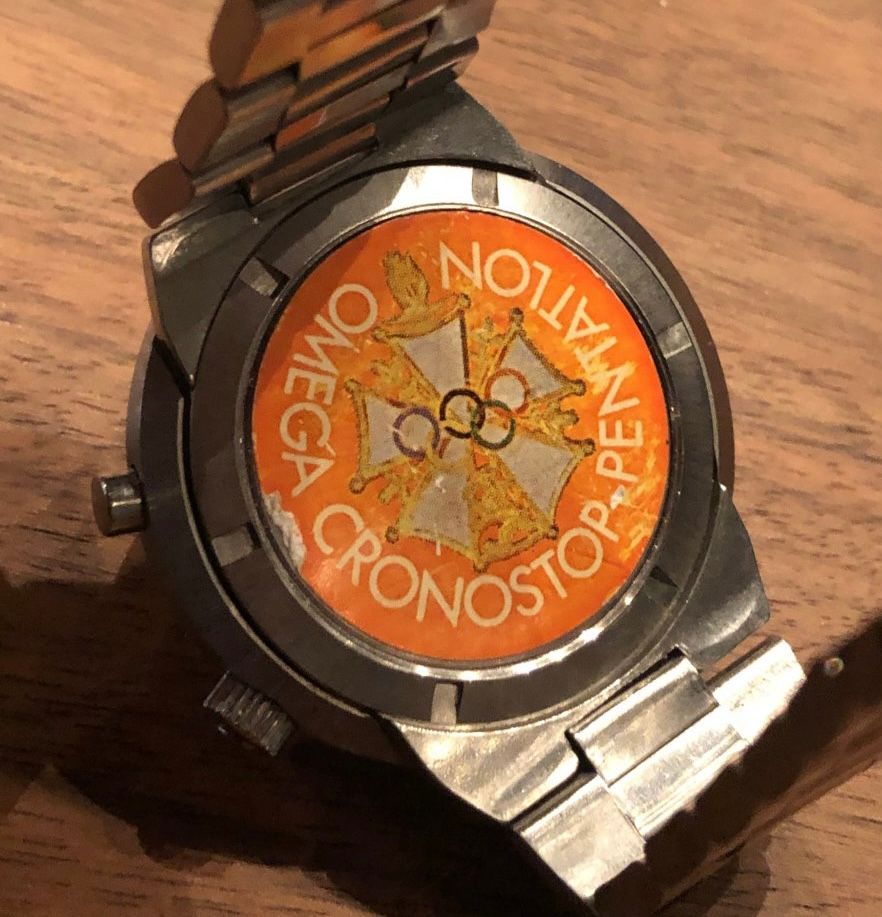
The Fontana name refers to a prominent Italian jewelry design chain. A member of the Fontana family also owned the watch case maker Lascor, a company that produced many cases for Omega including the Geneve Dynamic design, which was re-used on the 146.012, hence the connection. Lascor was subsequently purchased by Swatch Group and continues to exist as a part of the group even today.
The De Ville Chronostop
We know Chronostops come in Seamasters and Geneves but they also made De Villes, which very few people are aware of. The "why" behind this is a question would have to be addressed to some of Omega's employees of the 1970s, however the result surprisingly nice and very attractive.
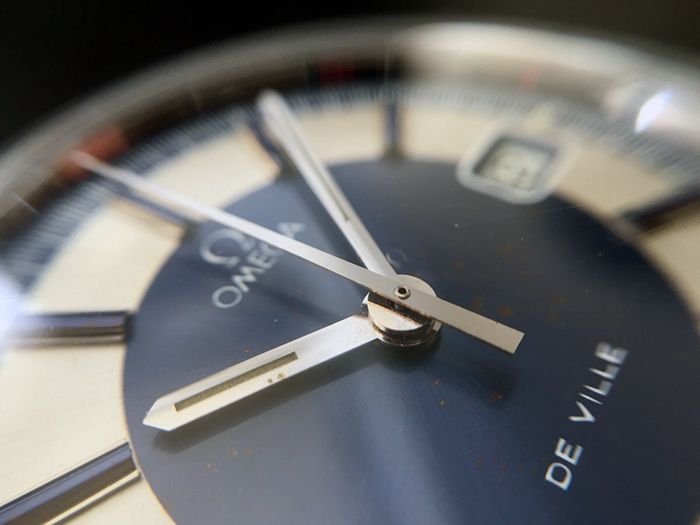
The best explanation I can think of is that Omega wanted some degree of separation between the more austere designs of the Italian market Geneves and the more dramatic designs used in these De Villes. What makes this a bit odd though is the fact that the blue dial in particular is quite similar to a Geneve Dynamic dial variant which already existed. Geneve or De Ville... they look bloody fantastic!
Cases & Bracelets
The case used on the 146.012 is vastly different from the original Chronostop models at a much larger 41.5 mm diameter and with a Geneve Dynamic style case and bracelet design.
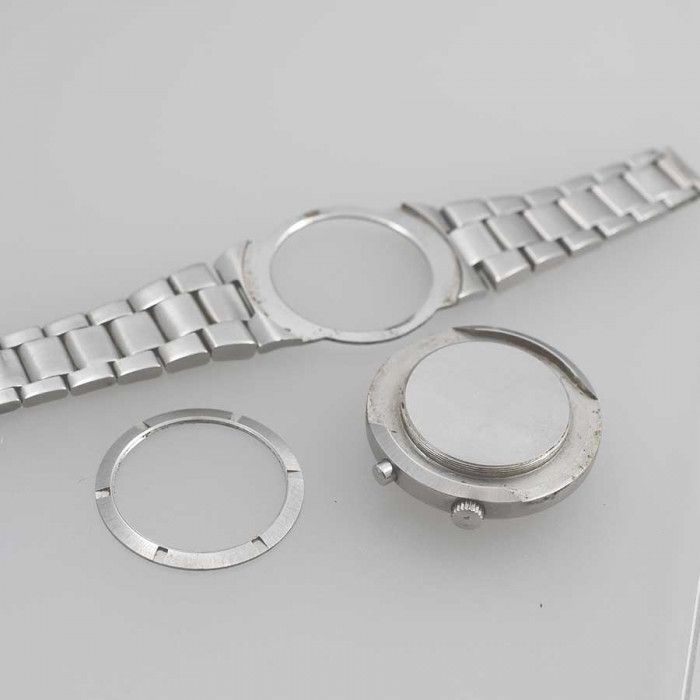
The watch case itself is front-loading, opened by removing the crystal with a special tool and definitely best left for your watchmaker to take care of. There is no removable case-back, and the main case section does not even have lugs, looking like a UFO on its own when disassembled. The lugs are part of a removable, ring-shaped carrier piece, which in turn is secured onto the main case section via a locking ring.
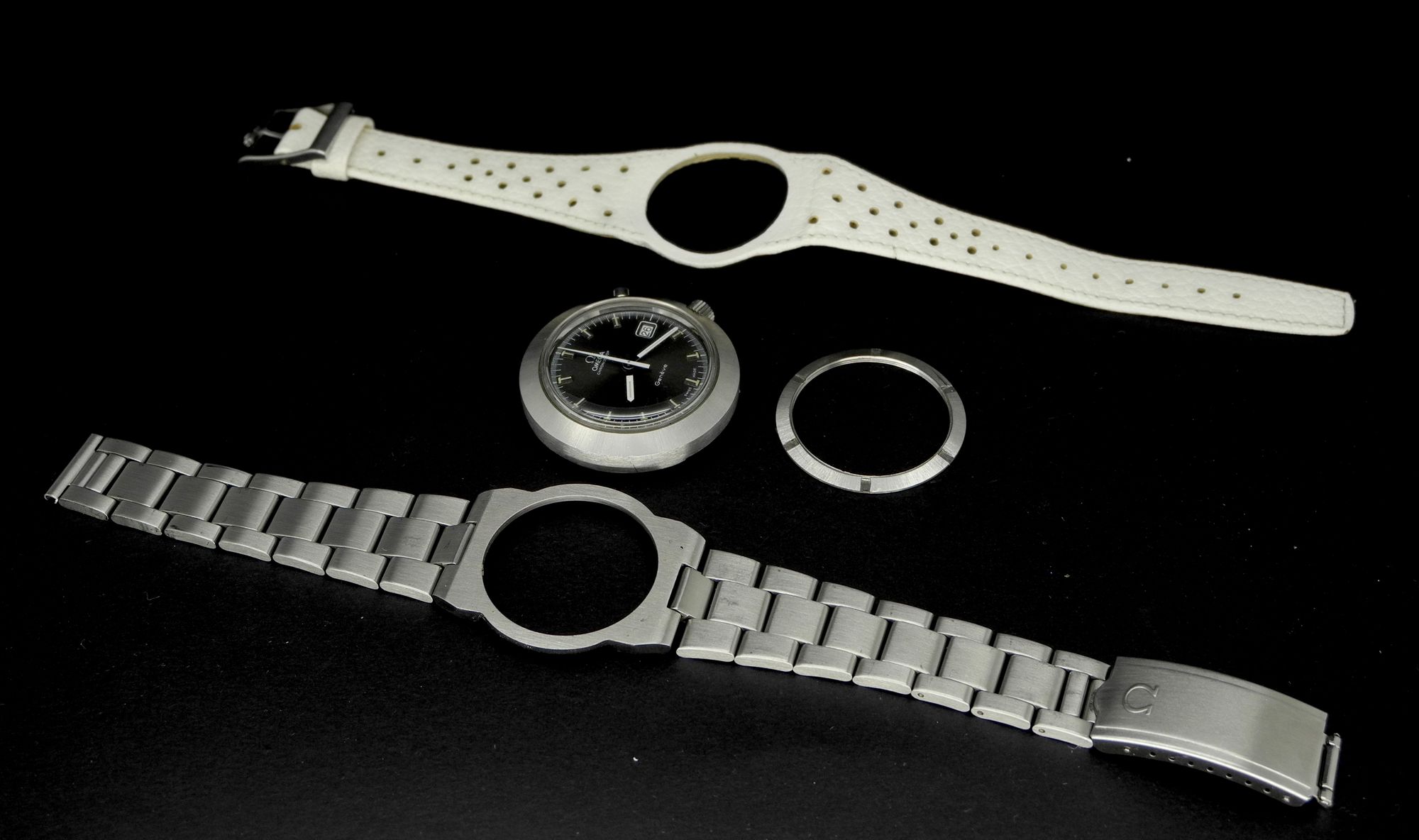
The major advantage of this design was originally the fact that the bracelet could be swapped out rapidly with use of a special tool in favor of a Corfam strap. These straps are very few and far between, and Corfam as a material is somewhat terrible, but there are aftermarket strap makers that do produce them for these watches. It really is best in general though to stick to the standard bracelet which is in a style similar to the Oyster bracelet and quite comfortable, durable and light. There is no real lug width, per-se as there are really no lugs, the strap or bracelet are entirely dependent on the locking-ring system.
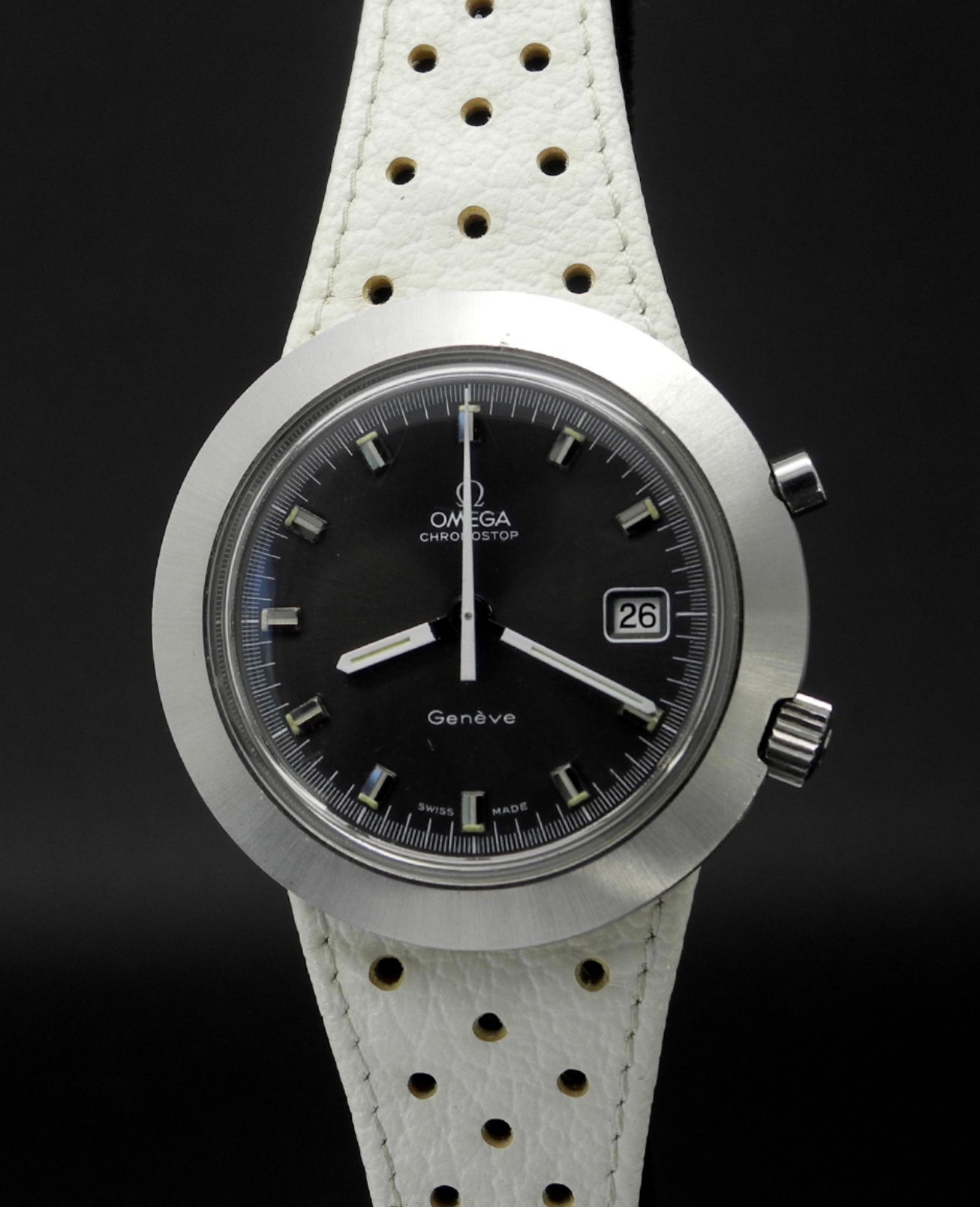
The bezel is integrated into the case rather than being a separate piece and can be brushed either radially or in a concentric pattern on Geneve Chronostop models, while the De Ville models can have polished bezels as well. The case is symmetrical with no crown-guards, featuring a knurled crown and a pusher that has the majority of its stem recessed into the case.
Movements
While there are two Chronostop movements, Cal 865 for non-date and Cal 920 for date, all variants of the Italian Geneve Chronostops as well as all De Ville Chronostops come exclusively in Calibre 920 with date.
This makes a lot of sense given that the case reference is 146.012 and a non-date version would be expected to have the reference of 145.012, which is already taken up by the legendary Speedmaster Pro.
As mentioned in part 1, the Calibre 920 is derived from the highly regarded Calibre 861 movement found in the Speedmaster Professional Moonwatch. The family has proven over many decades to be highly reliable, accurate and maintainable, with the latest Calibre 3861 Co-Axial movement still based on the original Cal 861 design.
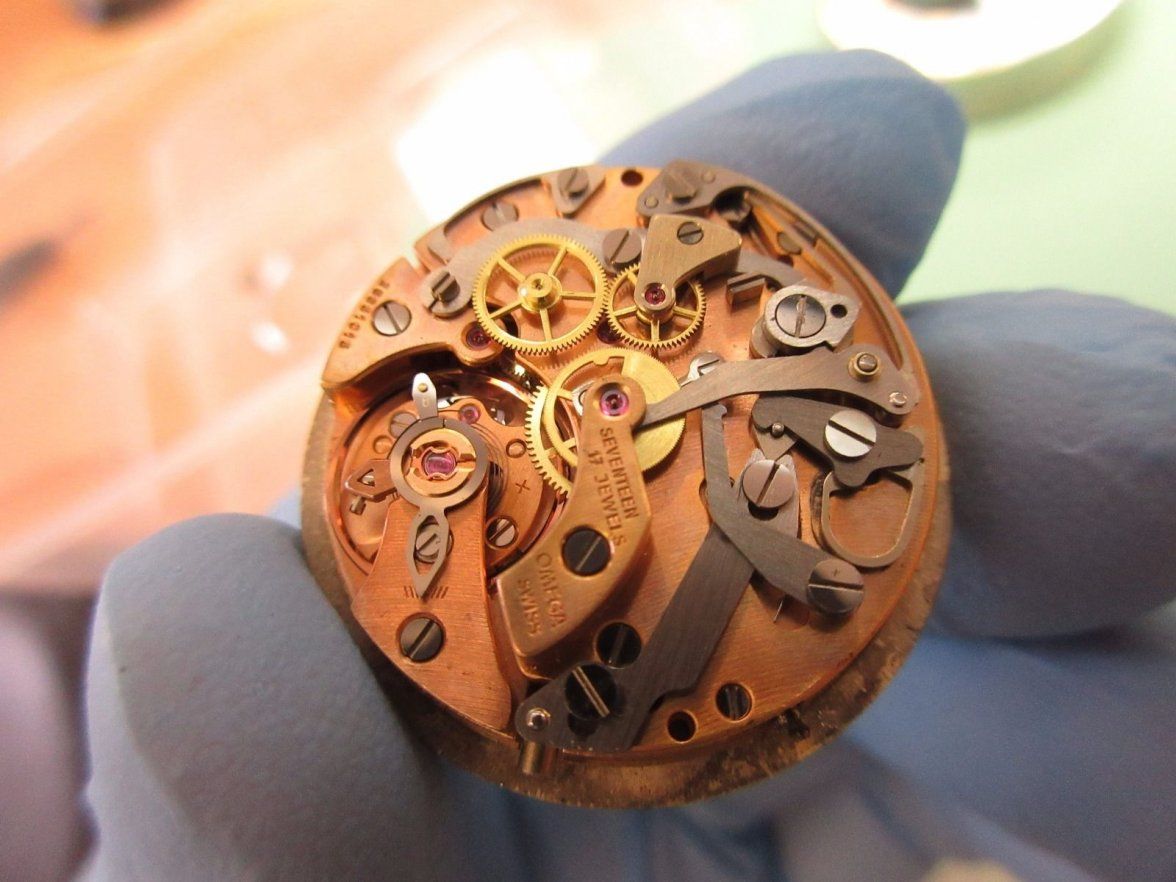
The Calibre 920 is manual wind, beats at 21,600 vph and lacks both hacking and quickset date. The calibre is not chronometer rated, however when serviced correctly can reach quite good levels of accuracy. Being derived from the Calibre 861, the chronograph mechanism found in these movements is a cam and lever design. It differs here from the 861 in that there is only a single pusher for all three functions rather than two.
This means that the same pusher will function in the order Start -> Stop -> Reset before starting again on the fourth press. This also means that once the chronograph has been stopped, there is no re-starting it without resetting first as the sequence is dictated by the position of the cam with a single pusher configuration.
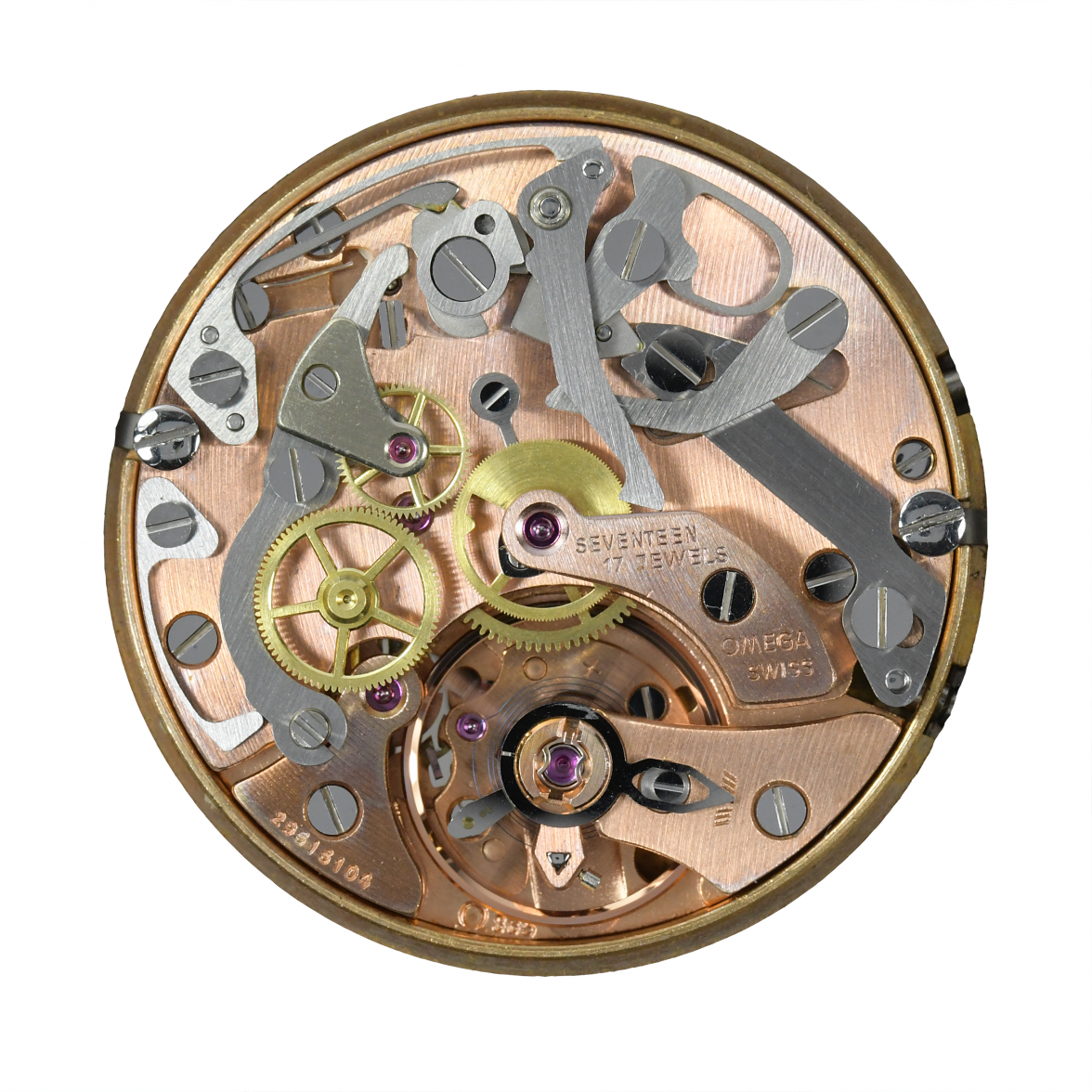
Parts for these watches are still available and they can be serviced by any qualified watchmaker with access to an Omega parts account. It is worth keeping in mind that these movements are more expensive than most vintage Omega calibres if needing a whole donor movement. Also, a watch with many worn parts can add up to a somewhat large bill on these movements. If buying one you are best to have it serviced prior to using it, in order to minimise any wear-induced parts bill.
While the Lemania dial variants shown below do not have Omega written on them, they too can be serviced by a watchmaker with an Omega parts account and it is best for practical reasons to treat them as an Omega given Lemania's lack of retail presence. Given that they are both part of Swatch Group, it is unlikely that anyone at Omega will mind.
Dial Variants
The 146.012 cases can be broken down into three groups of dials, the standard Geneve dials, the Geneve racing dials, and the De Villes. The least common by far are the Lemania Racing & De Ville variants, which are certainly uncommon in both forms yet don't really carry a premium with that rarity. The most common would be the standard silver and black dials, while the metallic blue and Omega Racing versions are somewhat less common.
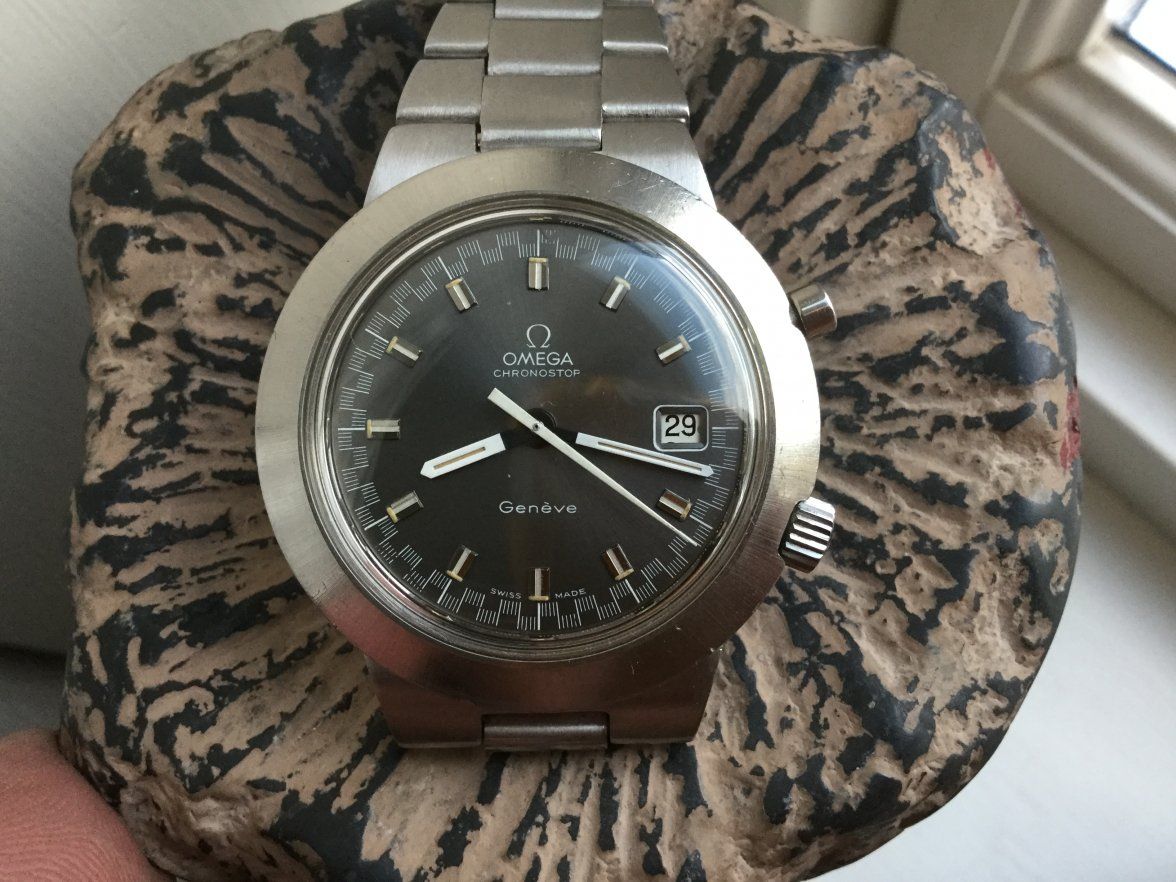
One strange thing about these Geneve Chronostop models is that they all have luminous hands and dials, yet there are no T markings for tritium at the bottom of the dials, except on the De Villes.
Standard Geneve Dials
The standard dials are very clean, highly legible, and have the appearance of a timing instrument with their sub-seconds track and small hour markers. While subtle, they are very attractive at the same time, all featuring starburst metallic dials in silver, dark grey and blue, they catch the light and can look very different depending on the angle and lighting.
All three use thicker, sports watch style hands with luminous material in both them and in the dials. Those hands are black against the silver dial, and white against the dark grey and blue dials for improved contrast. Similarly, the dials have contrasting dial paint, black on the silver dial and white on the dark grey and blue. This paint extends to the tops of the applied metal hour markers which have a black line of paint across the top of them in the silver dial and white lines across the top of the dark grey and blue dials. The luminous material is applied in a line rather than a dot, on the outer edge of all hour markers.
While there is no applied Omega logo or date window, these had been largely phased out by the 1970s when these watches were released, and Speedmasters of the same era were similarly painted.
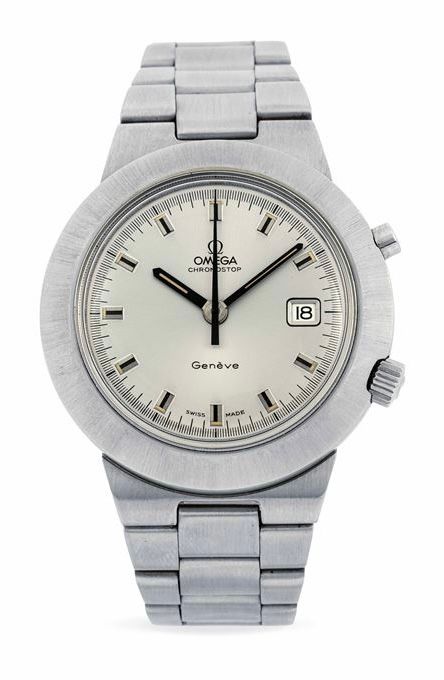
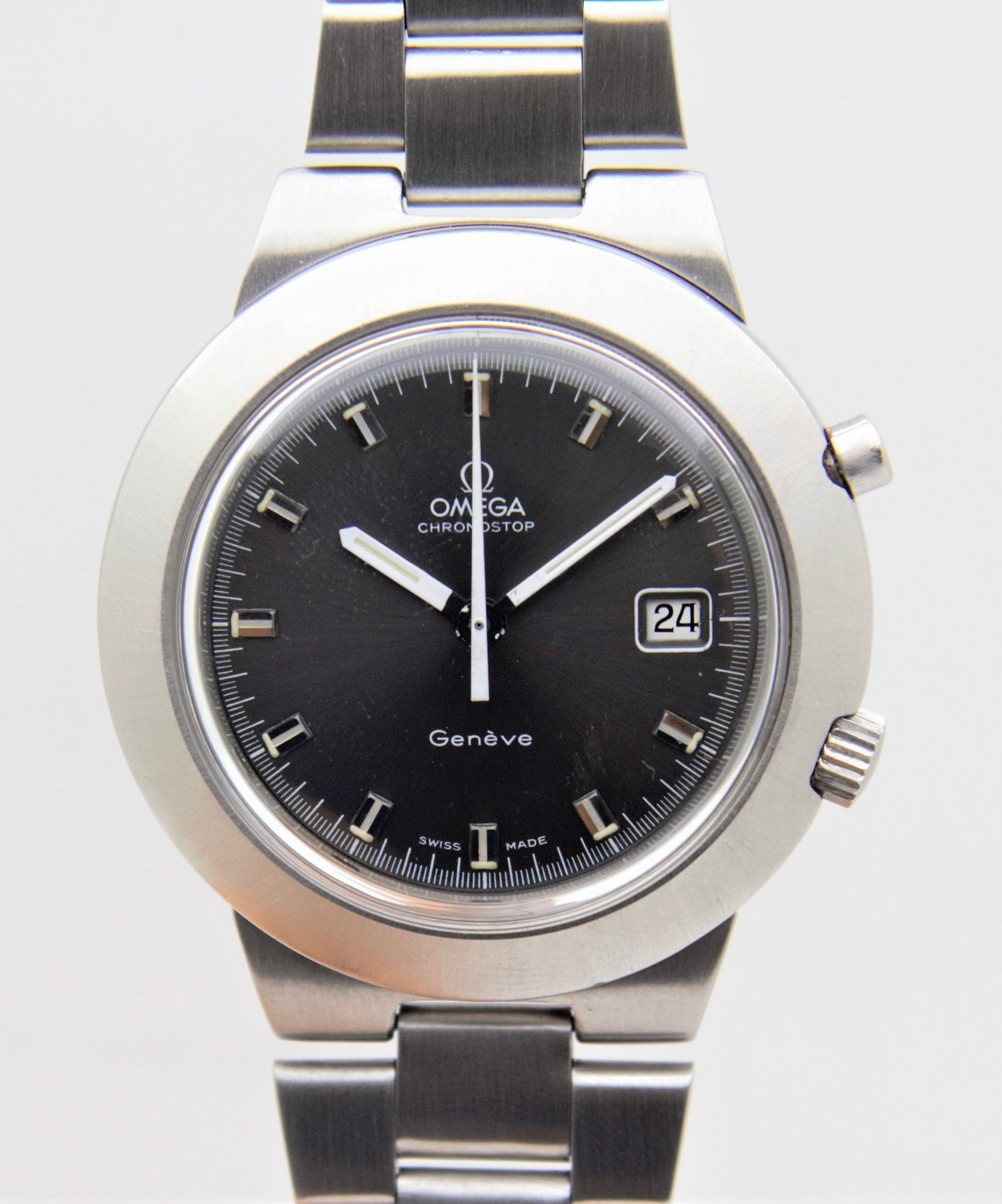
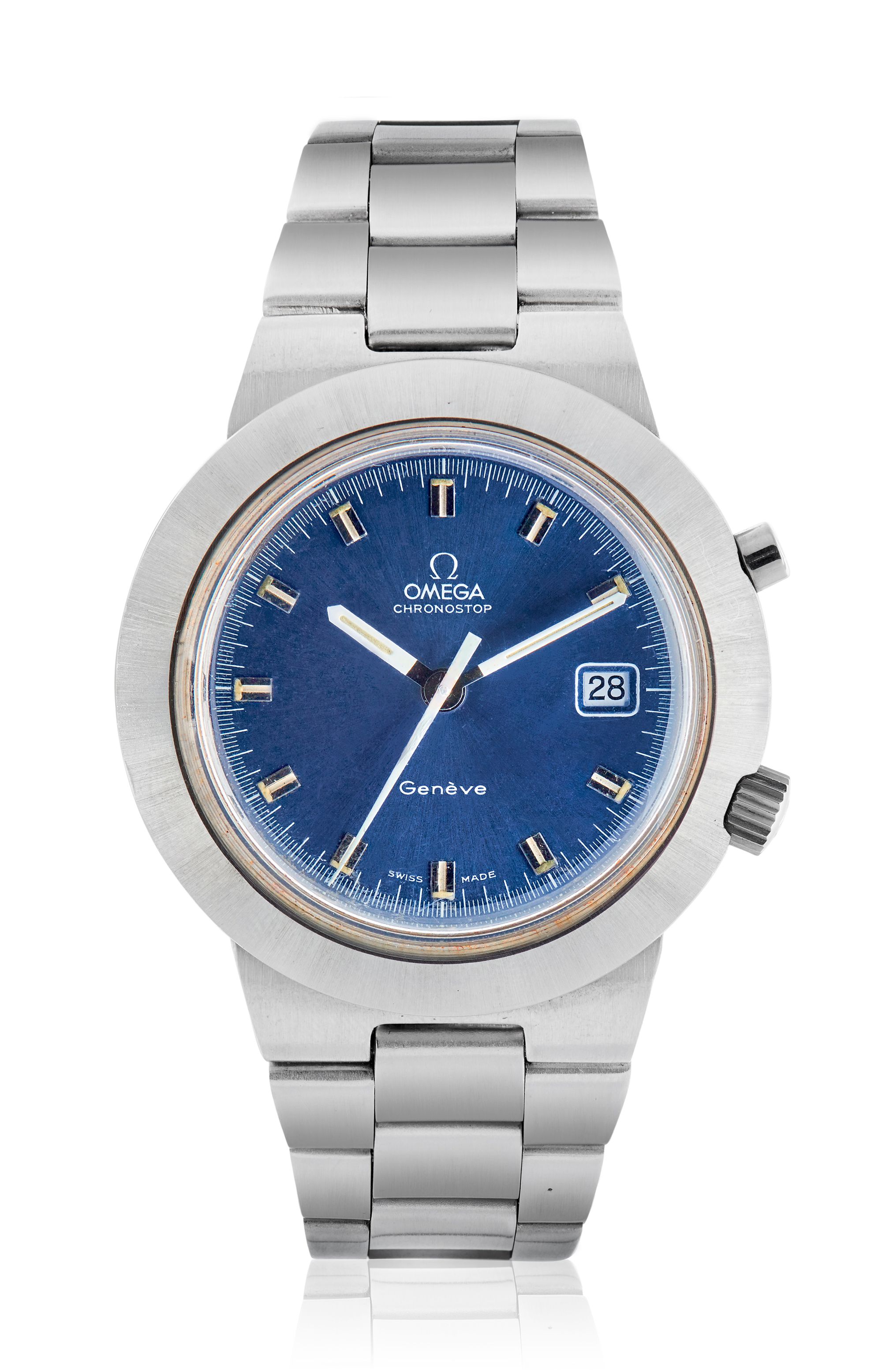
Geneve Racing Dial
The racing dial is only available in dark grey starburst and is almost identical to the standard dark grey dial, with a few subtle changes.
Firstly, and most significantly, the regular sub-seconds track is replaced by the "racing" sub-seconds track, which is a lot thicker and alternates up and down for each second. The reason for doing this is to make it easier at a glance to identify the exact sub-seconds, and to then find the seconds to add this to without getting visually confused among a row of otherwise identical hash marks. It does succeed in improving legibility quite well and gives the watch a much more sporty look and feel.
As a result of the increased thickness of the sub-seconds track, the hour markers are actually moved inwards by just over 1 mm. You can actually see the difference if you compare the standard and racing dial side by side and note what part of the minutes hand the hour marker ends on.
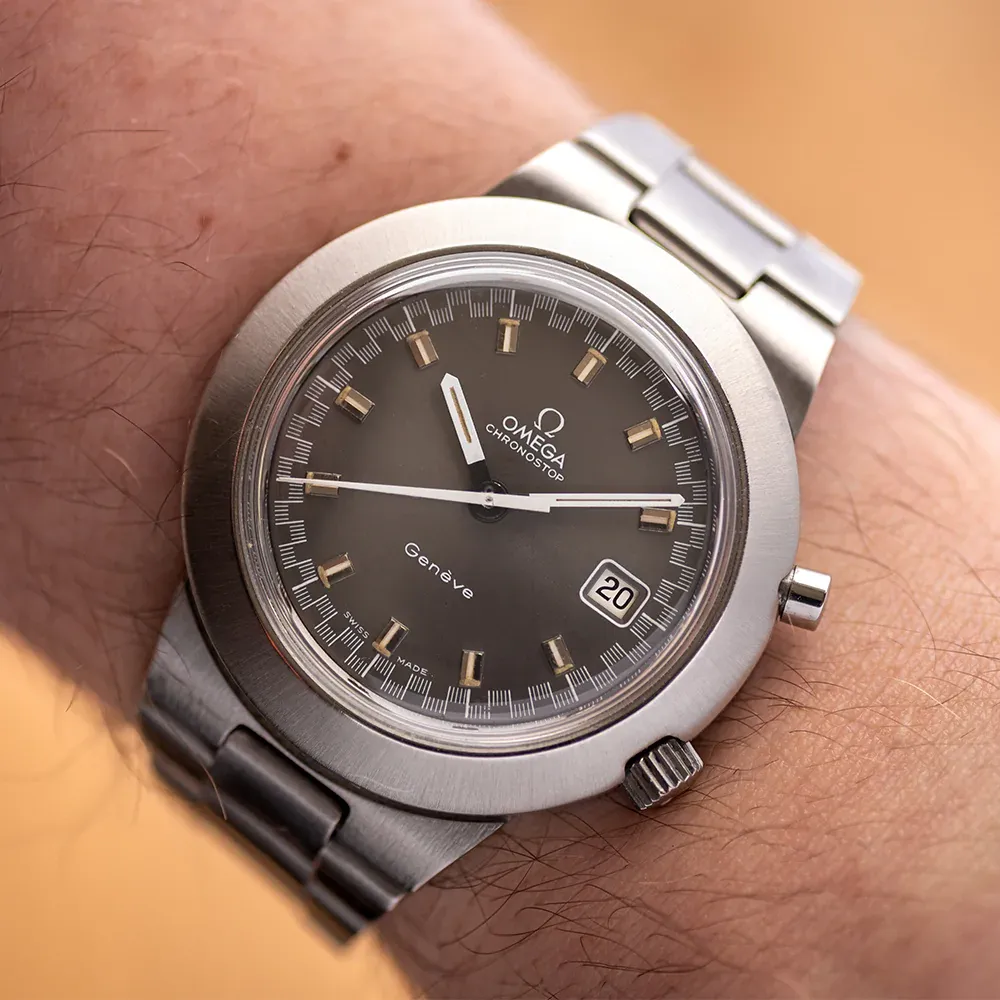
Lemania Racing Dials
The Lemania dials are an oddity and quite a rare one at that. These watches have Omega signed crowns, clasps, cases, straps, movements and feature the exact same dials as the standard and racing variant Omega Geneve Chronostop 146.012 models. Yet they bear the Lemania crown logo at the top, and the only writing on the dial is the ambiguous word "Racing" at the top.
Lemania was a sister company to Omega within SSIH, and was the manufacturer of the Calibre 920 movement, along with the 861, 321 and many other of Omega's most famous chronographs. It is hard to know what to categorise these as, they're too common to be called prototypes yet too uncommon to have been made in any significant quantity.
While they don't have an Omega dial, I would still consider these to be as much an Omega as any other based on the sum of the parts. Asking prices can be on the high side due to the perception of these as rare prototypes, realistically they don't seem to sell for any real premium and are an interesting addition especially for lovers of Lemania.
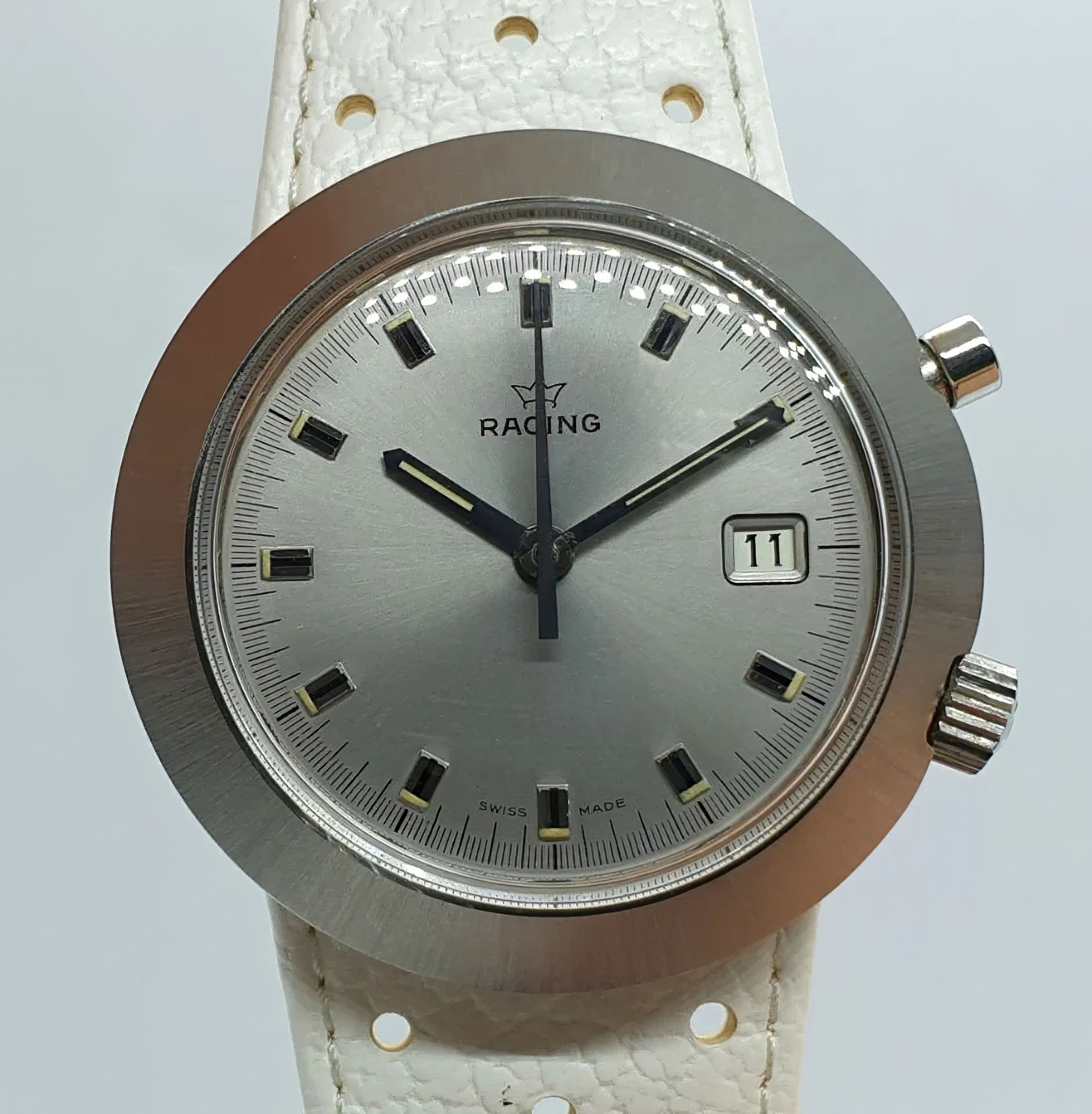
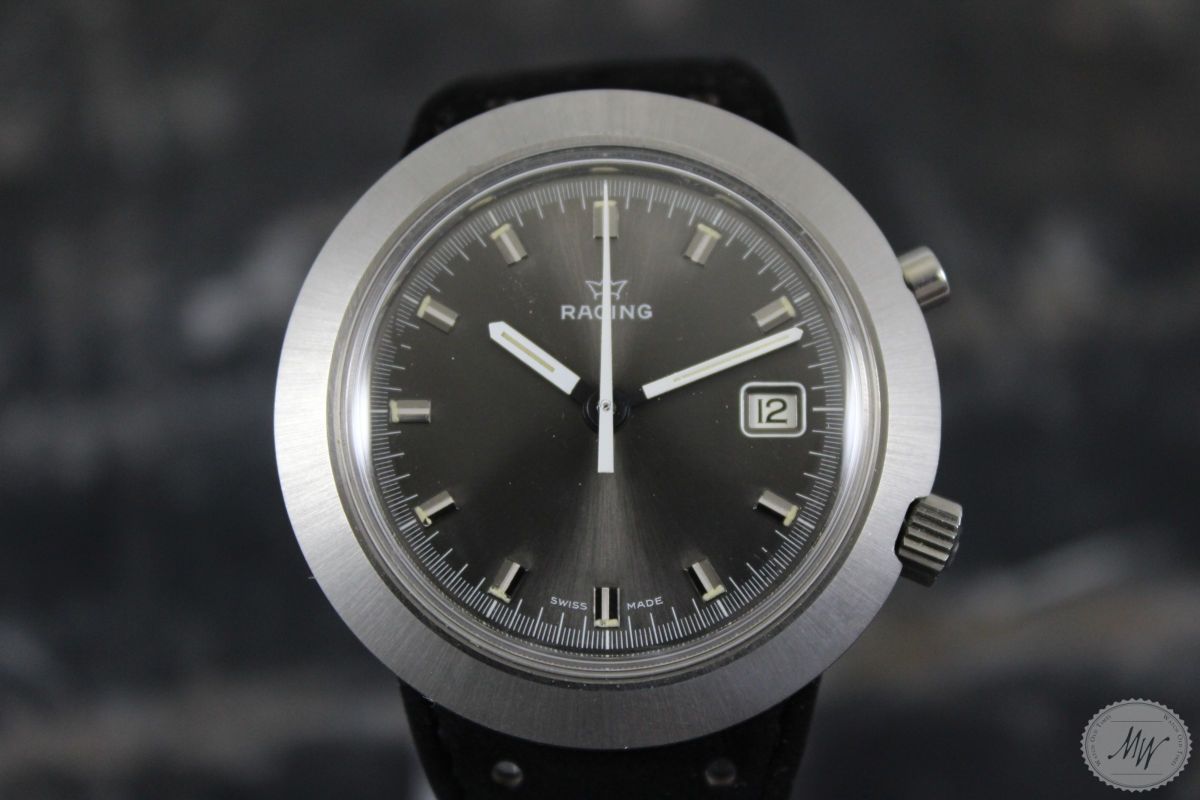
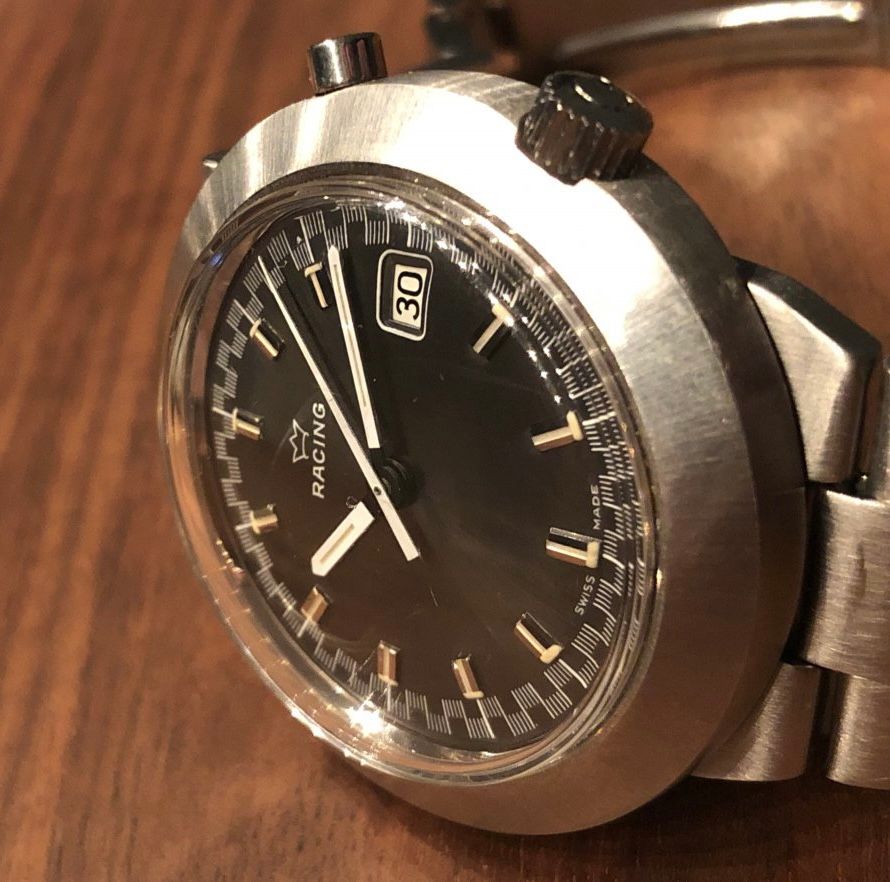
De Ville Dials
The De Ville dials are very unusual, totally unique in design from any Geneve and very unlike each-other as well. Only two exist, one being a two-tone metallic blue and silver tuxedo dial, while the other is a white to dark grey color-fade. Both feature unusually polished bezels, unlike the brushed bezels found on all other 146.012 references. Additionally, they both have similar white text for the Omega logo and the words De Ville on the dial, as well as a white painted ring around the date window and white sub-seconds track around the outer edge.
The dial furniture differs on the two watches, being significantly longer, although similar in design on the color-fade dial, although the all-silver hands with luminous material are identical on both as are the lume plots on the outer edge of the dial furniture.
The existence of these dials is rather unusual, and it is somewhat hard to understand why a De Ville was made at all in such small quantities. That said, I'm very glad they did, because these dials look terrific, and the metallic starburst blue tuxedo dial may just be my personal favorite of the entire Chronostop collection.
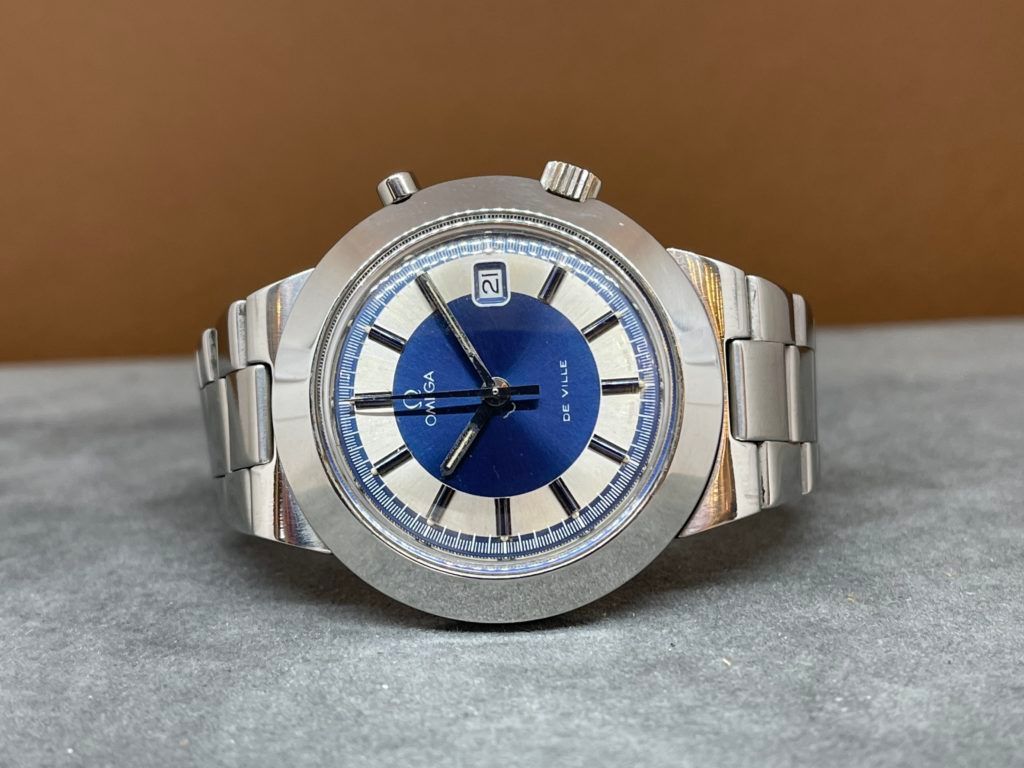
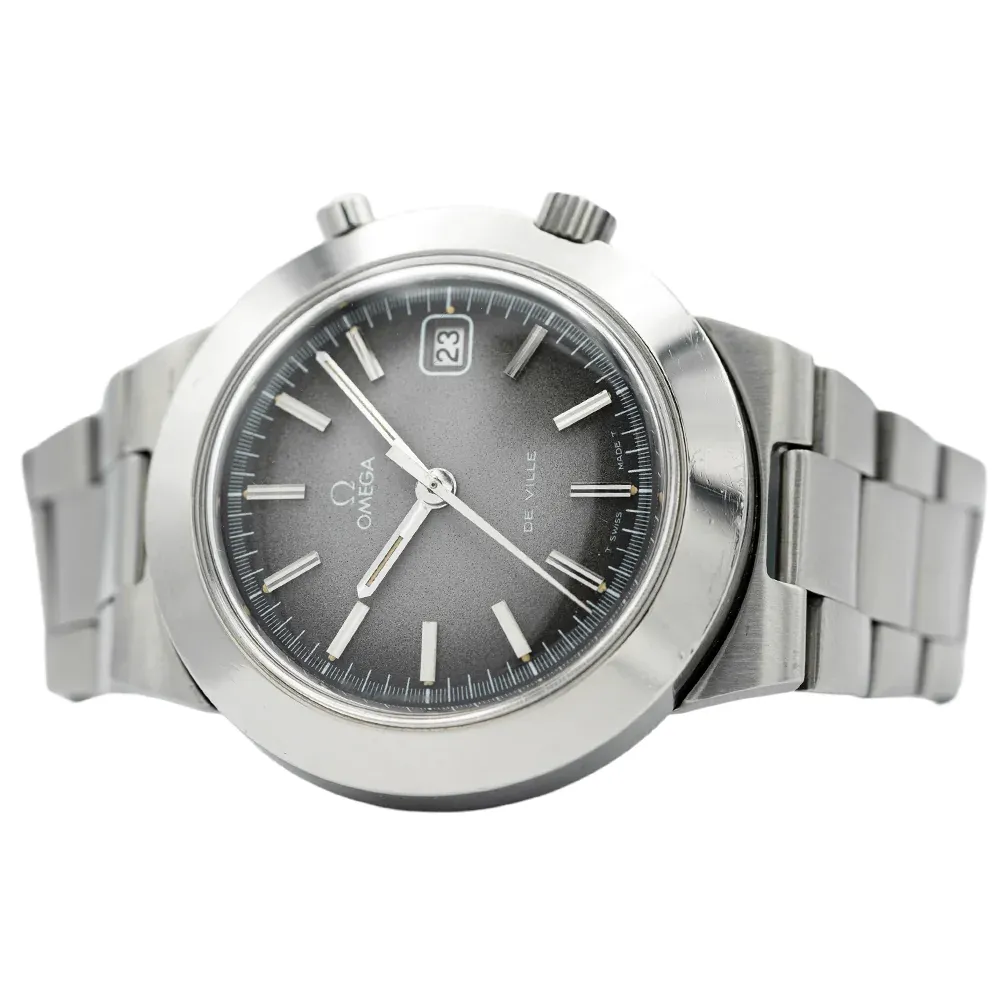
Buying
While the majority of these watches were originally sold in Italy, they are widely found around the world today as the Italian market is extremely efficient and led to many being exported for higher prices years ago.
There is a lot of variety in the 146.012 models in terms of dial options, and there really are no bad or boring choices, they're all highly attractive and desirable. As a result, prices are fairly even across the range at around $1,500-2000 with the exception of the Lemania Racing dials which can command higher prices as a result of people considering them to be "prototypes", mostly the people selling them.
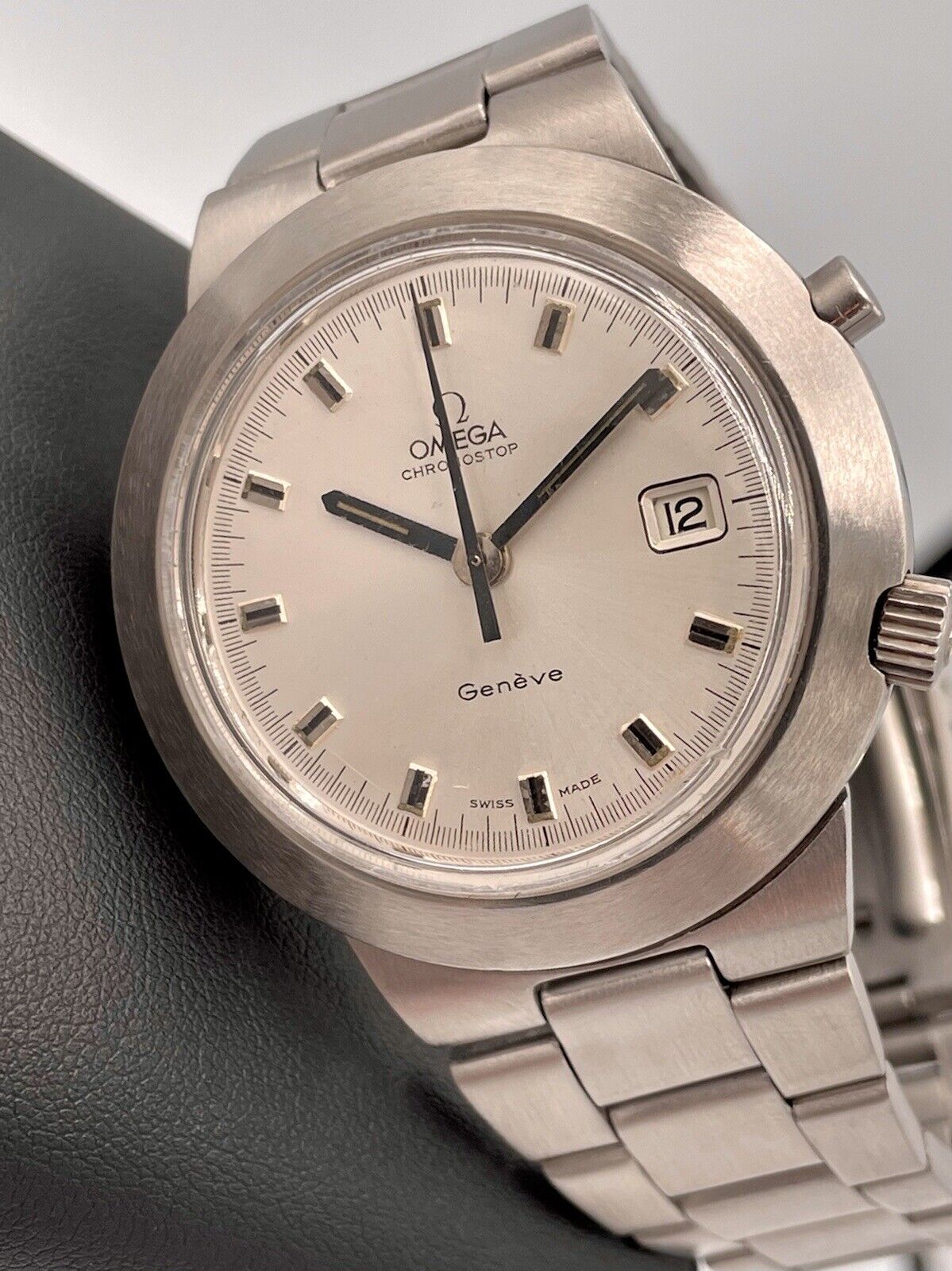
They can be found frequently on forums. eBay and Chrono24 without much trouble so it really is a matter of just finding the right balance of cost and condition. The design of the 146.012 case is not as sensitive to polishing as the original Geneve in that there are no soft edges, only hard ones. That said if you come across one that looks rounded or soft around the bezel transition to the sides of the case, someone has gone crazy with the polishing wheel and it should be left alone.
The entire bracelet, including the center piece with the lugs is separate and can be replaced if needed however they are not overly common or cheap. It is very much worth getting a bracelet version over a strap version, partly as the original Corfam straps are not very nice, and partly because of the cost of acquiring a good bracelet after the fact.
Dials should be original and clean, as these front loading cases are quite decent in terms of water resistance and replacement dials are effectively unobtanium. There are enough nice examples that it just isn't worth settling for any dial that is less than clean and original.
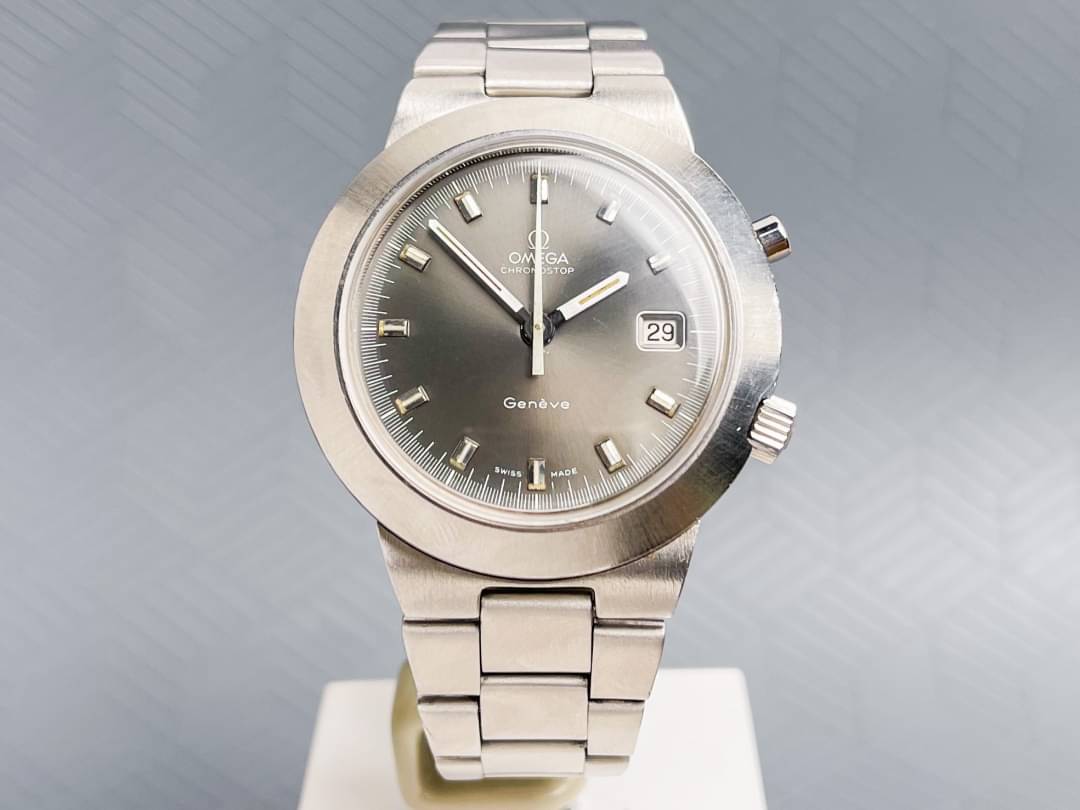
The servicing costs on these watches can be high, even through an independent watchmaker just due to the fact that parts can add up. That said, if you are purchasing one of these watches, the cost involved and risk of causing more metal on metal wear is such that I would strongly recommend servicing before wearing.
These watches are in my view the pick of the Geneve Chronostop types, with their larger size, modern aesthetic and attractive dials making them an extremely compelling option at a rather small premium over the original Chronostop models. Due to the more limited supply, it may take slightly longer to find the right one but the metallic blue dials in particular are very special and well worth adding to your collection.
Discussion thread on Omegaforums can be found here:
